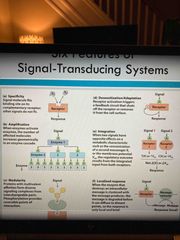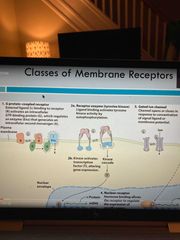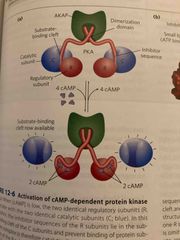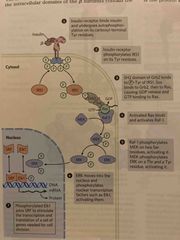![]()
![]()
![]()
Use LEFT and RIGHT arrow keys to navigate between flashcards;
Use UP and DOWN arrow keys to flip the card;
H to show hint;
A reads text to speech;
27 Cards in this Set
- Front
- Back
|
Receptor |
Membrane bound or soluble protein or protein complex which exerts physiological effect after binding its natural ligand |
|
|
Receptors bind specific lingands |
Small ions, organic molecules, polysaccharides,Peptides (insulin), Proteins |
|
|
Six features of signal transfixing systems |
Pic |
|
|
Classes of membrane receptors |
G protein coupled receptor Receptor enzymes Gated ion channel Nuclear receptor (steroids) |
|
|
G protein coupled signaling |

7 Alpha helical integral membrane proteins Heterotrimeric (alpha, beta, and gamma ) tri complex that binds to GTP Mediate signal to other target proteins |
|
|
Epinephrine (g coupled) |
Made in adrenal glands Mediated stress response: mobilization of energy- binds to receptors in muscle and live for breakdown of glycogen, adipose cell for lipid hydrolysis Bonds to heart receptors to increase blood flow |
|
|
How G coupled protein works with epinephrine |

S means stimulating G protein The GDP is converted th GTP causing it to move and activate adenylyl cyclase That activation causes activation of cAMP which then activated protein kinase A (PKA) Phosphorylation of Proteins by PKA creates cell response cAMP is degraded reversion activation of PKA |
|
|
CAMP |

Allosteric Second messenger Activated cAMP-dependent proteins kinase a (pka) Phosphodiesterase degrades cAMP PKa activation leads to activated enzymes that release glucose for glycogen |
|
|
6 signal transduction system |

Pic |
|
|
Classes of membrane receptors |

Pic |
|
|
PKA activation |

2 subunits: regulatory and larger catalytic Inactive, regulatory extend into catalytic blocking binding site cAMP bonds to regulatory subunits and removes them from the catalytic so they can go off and bind |
|
|
Signal amplification |

Activation of adenylyl cyclase enzyme make several cAMP molecules which activate even more PKAs which then activate thousands of glycogen degrading enzymes |
|
|
Self-inactivation mediated densensitization in G proteins |

Epinephrine is short acting so stopping glucose synthesis is needed when threat is gone Down regulation of cAMP occurs by hydrolysis of GTP in alpha subunit In G protein, GTP is turned back into GDP reducing affinity to adenylyl cyclase |
|
|
Modulators of G protein activity |

GTP-GDP exchange factors (GEFs): helps to go from GDP to GTP GTPase: helps to go from GTP to GDP |
|
|
DeSensitization of beta-adrenergic receptor (bark) |

1. Bark is recruited to membrane to phosphorylate Ser residues at the carboxyl terminus Barr, beta arrestin, binds to this end then Barr Enters cell by endocytosis |
|
|
Localized response |

Targeted to rafts All it needs in one location |
|
|
Secondary messengers activate other secondary messengers |

A G protein can activate phospholipase C (PLC) which cleave PIP2 to IP3 and diacylglycerol IP3 goes to ER and bind to ligand-gated ion channel to allow Ca to leave ER Ca and the diacylglycerol can activate protein kinase c together |
|
|
Calmodulin |

4 affinity binding sites for Ca Like a Ca sensor, changes shape when Ca binds to it Key in neuronal binding |
|
|
G protein can be inhibitory or stimulatory |
A |
|
|
Enzyme linked membrane receptors |

2 categories Have tyrosine kinase activity adds phosphate group to itself and to specific target proteins Have gaunylyl cyclase activity that convert GTP to cGMP |
|
|
Insulin signaling cascade: ligand binding |

Insulting binds at ligand site Dimer so auto phosphorylation occurs, asp phosporylates IRS-1 on its tyrosine residues This ignites other proteins engagement and then a cascade of other proteins being phosphorylated
|
|
|
Crosstalk btw tyrosine kinase and G proteins (integration) |

2 signals with opposite effects on a metabolic characteristic such as concentration of sending messenger or membrane potential |
|
|
IRS-1 can also activate others (modularity) |
Activated PKB which can activate G5K3 so variety of ways to activate glycogen with insulting Adapter proteins: proteins with different affinities and characteristics can form complex |
|
|
Auto inhibition in tyrosine kinase |

Pic |
|
|
Gated ion channels |
Respond to changes in membrane potential and ligand binding In nervous system-Voltage gated |
|
|
Electrically charged membranes |

3 Na out and 2 K in. Maintain -50 to -70. |
|
|
Voltage and ligand gated ion channels |

Depolarizing stimulus opens Na channel allowing Na to rush in and bringing mV up into positives After Na channels, K channels open to get K out of cell-repolarization At the end of axon, voltage gated Ca channels open for influx of Ca to activate SNARE complexes to create vesicles of NT to be released NT travels across synapse (with some NT being removed from synapse by enzymes) and activated next neuron at its receptors (ligand gated channel) to start depolarization in this neuron |

